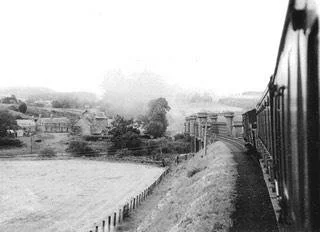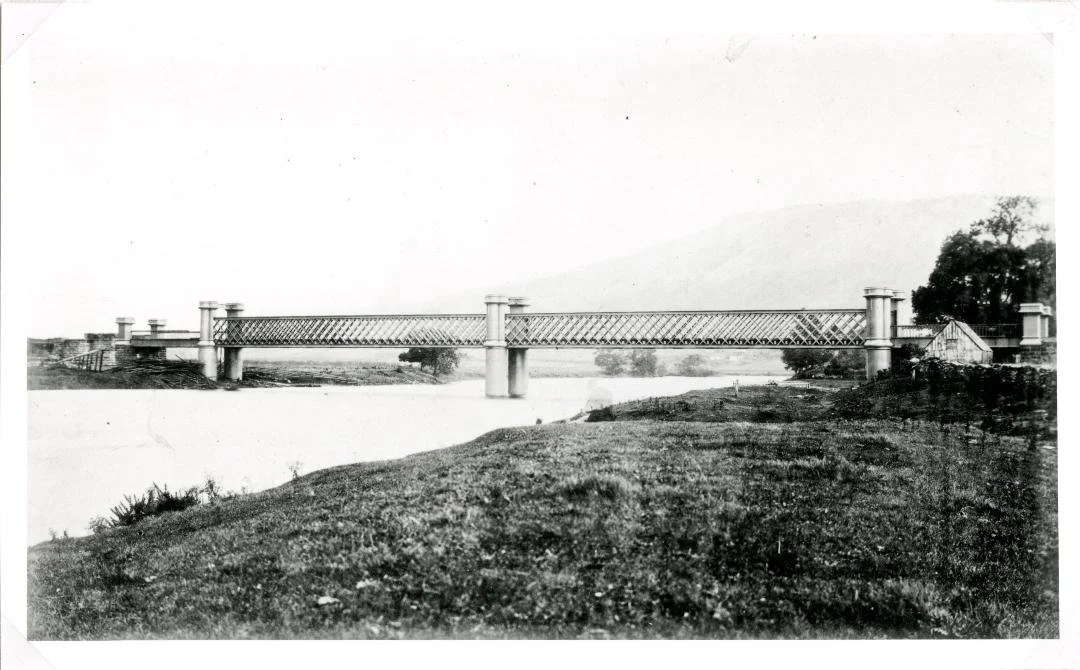Logierait Viaduct
Highland Railway
The viaduct, over the River Tay, at Logierait, formed part of the branch line from Ballinluig to Aberfeldy. It was part of the Inverness and Perth Junction Railway later renamed the ‘Highland Railway’ when the company merged with the Inverness and Aberdeen Junction Railway in 1865. The line from Dunkeld to Pitlochry opened in June 1863 and the whole line was completed in September when the Aviemore to Pitlochry section opened. Journey times throughout the north were greatly reduced, but to travel to London still took eighteen hours.
The construction of the line to Aberfeldy was always planned as part of the original concept for the railway and it opened in July 1865. It had to cross both the rivers Tummel and Tay. Viaducts were constructed to cross the rivers, the Tay viaduct at Logierait. The Tummel viaduct was demolished in the 1980s, having been adapted to carry the A827. It was removed to allow a new road bridge, leaving only a trace of its foundations visible.
Construction
The engineer responsible for the design of the bridge was Joesph Mitchell of Inverness. He had originally surveyed the Highland route in 1860. The metal work for the bridge was produced in Manchester by the Fairbairn Engineering Company and the contractor was Gowans and McKay. The strength of the viaduct comes from wrought iron lattice girders. They are supported by cylindrical iron piers filled with stone rubble and concrete. The shorter spans are of plate girder construction. The main spans are some 137 feet and the side openings 41.5 feet. The two shorter side openings over land were made of plate girders, and were to allow flood water to pass. Before passenger use of the Viaduct was begun, the four heaviest engines on the line were driven onto the bridge to ensure its strength. The appearance of the bridge with its cast iron pilasters resembles the bridge at Dalguise. The Pilasters were insisted upon by the sixth Duke of Atholl as a condition of being able to build the bridge. That they are cast iron and not stone like the bridge at Dalguise saved a considerable sum of money, but have no structural function and serve only to make the bridge more imposing. The cost of the bridge was £13772, equivalent to over £1.7 million pounds in 2020.
Operations
From the outset the Aberfeldy branch line carried both passengers and freight. When the line opened Aberfeldy was growing rapidly and the arrival of the railway greatly facilitated the growth of the town, as well as providing the local farmers access to markets far from the locality. After Queen Victoria and her consort Prince Albert bought Balmoral in 1852 travel to Scotland became increasingly popular and the railway allowed much safer and easier travel bringing a new type of visitor, the tourist.
The distillery in Aberfeldy opened in 1898 and took advantage of the railway to deliver barley and ship whisky to their warehouses in Perth. There were two sidings at the distillery and a short section of track remains on which stands a tank engine built by Andrew Barclay of Kilmarnock in the 1920s.
For almost one hundred years the branch line served the local community and as times changed both steam and diesel engines served on the line. In 1965 just months before the line’s centenary the axe fell, wielded by Dr Beeching and following his 1963 report, the "The Reshaping of British Railways". Within months of the line's closure the track had begun to be removed.
Kinnaird
The Logierait viaduct was sold to the local Kinnaird estate in 1967. The track bed was converted for vehicle use by the estate and it became an essential route for the community who would otherwise have to travel via Grandtully further up the valley in order to cross the Tay. Over the years the condition of the bridge deteriorated and in 1991 fearing the bridge had become unsafe the estate attempted to close the bridge to public access. To prevent the closure two local residents sought interdicts at the High Court in Perth, which were awarded unopposed by the estate.
Logierait Bridge Company
In 1994 The Kinnaird Estate sold the bridge for £1.00 to a newly formed community company, the Logierait Bridge Company. Their objective was simply to maintain a road link, via the Logierait Bridge, for the communities on either side of the river Tay. This means the bridge is the only bridge in Scotland owned by its community. The locally elected board set to work to raise the money required to repair the bridge. This turned out to be nearly £400,000. This huge task was accomplished with the hard work of local people and the help of Historic Scotland, Perth and Kinross Heritage Trust, the Ellis Campbell Foundation, the Manifold Trust and the Rural Challenge Fund .
The work of restoring the Bridge involved installing new decking, safety rails and repainting. This work included the removal of old lead paint, which had the potential to impact the sensitive environment of the River Tay. The entire structure was sheathed in a plastic cocoon while the Bridge was stripped back to bare metal. After dry and then wet grit blasting, the wrought iron was repainted. Each of the thousands of rivet heads and exposed metal edges were painted by hand. It took until August of 1991 before the bridge could be reopened to traffic.
The board is still responsible for the maintenance of the bridge and have arranged to replace damaged timbers on the deck, cleaned the bridge and repainted worn areas. In 2018 divers were sent to check that the river bed had not been eroded at the base of the central pillars. There was no loss of material, but two pistols, one British one German were recovered. Presumably wartime souvenirs that the owner decided were a liability.
Community Service
The bridge forms a vital route across the Tay for those living by its side, for farmers and the emergency services. The costs of maintaining the bridge come from subscriptions by local people and businesses and by donations from both local and national organisations. The bridge also forms part of national cycle routes 7 and 77.
Historic Scotland has designated Logierait bridge as being of Historic and Architectural importance at its highest level, Grade A.
" All images copyright protected"



